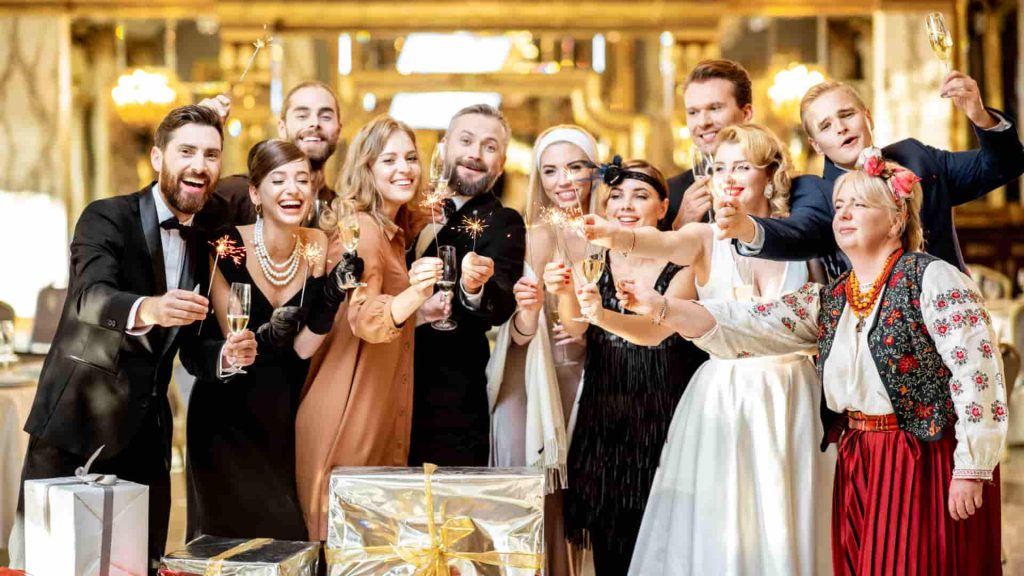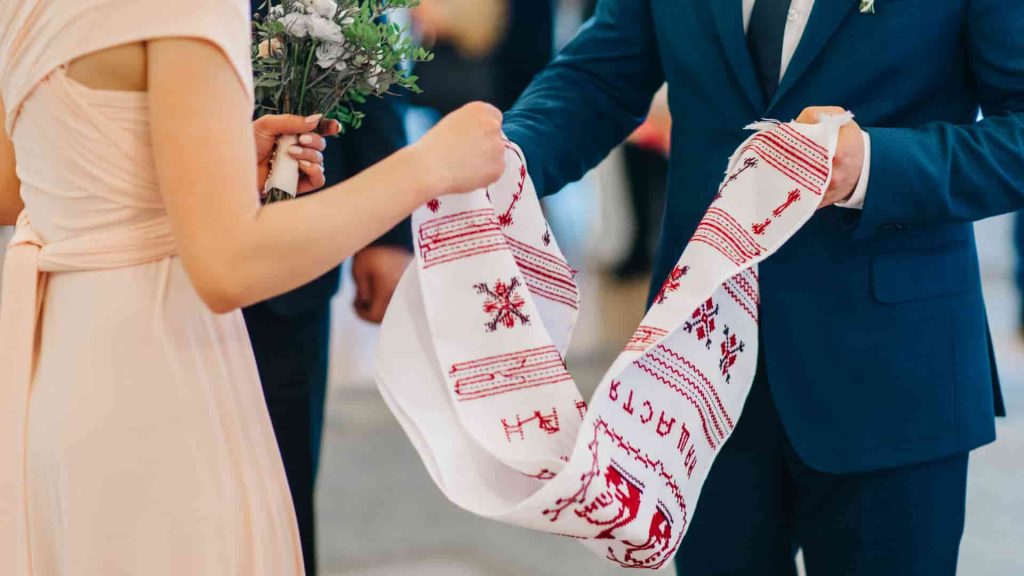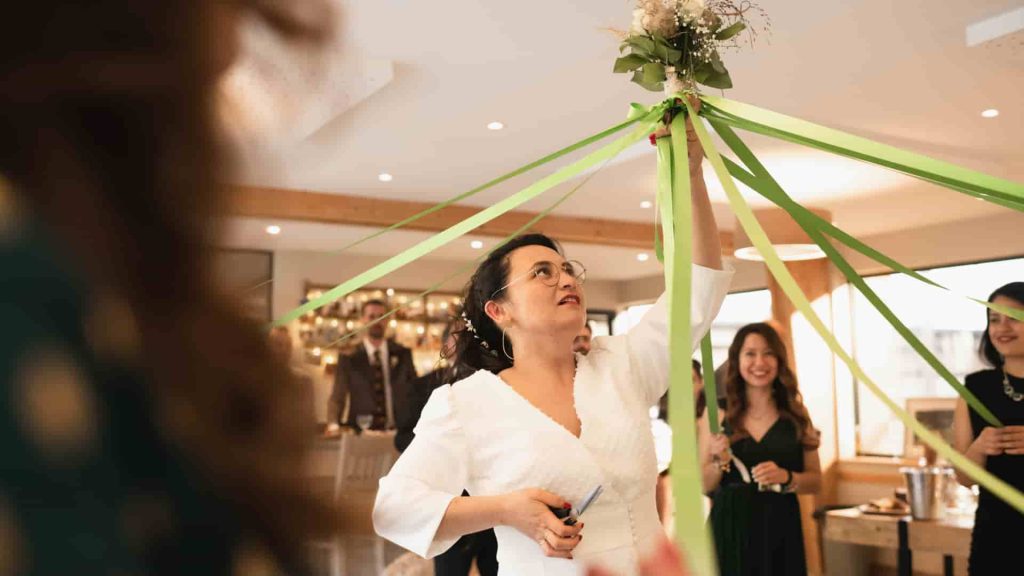
At a German wedding, excitement crackles like static in the air, especially when it’s time for the Brautstraußwerfen, a bouquet toss with an unexpected twist.
Picture the bride, poised with not one, but two bouquets. One holds the promise of marriage, the other, a whisper of an engagement. The crowd of unmarried women, their backs to the bride, can only guess which bouquet sails over – the real deal or the decoy? It’s a playful spin on fate, turning one of the common German wedding traditions into a guessing game wrapped in floral scents and suspense.
Keen to dive deeper into the heart of German wedding traditions, where old-world charm meets whimsical twists? Stick around as we unveil traditions that stitch together the fabric of celebration with threads of cultural heritage and sheer fun.

6 Uncommon, Unique German Wedding Traditions You Need to Know About
Weddings, regardless of where it is happening, is a celebration bound in tradition. Every country and community have their own set of customs that make it sacred, fun and unique. Here is our collection of the German wedding traditions worth looking at.
#1 Polterabend
Polterabend is the epitome of a vibrant send-off to singlehood, one of the German wedding traditions that’s as boisterous as it is symbolic. As dusk falls, the air fills with anticipation and a sense of camaraderie, setting the stage for an evening where porcelain is not just a dinnerware but a bearer of luck and joy.
Friends and family gather, armed not with gifts but with old ceramic dishes, tiles, and sometimes even toilets – anything porcelain, except glass, as it’s believed to bring bad luck. The air soon erupts with the sound of shattering porcelain, each crack a note in the symphony of chaos that is Polterabend.
Make sure to read: Learning to Love German Winters: 5 Places to Visit in the Winter
Why is it celebrated?
This raucous celebration is steeped in the belief that the noise and the breaking of porcelain scare away malevolent spirits, ensuring the couple’s journey begins on a fortuitous note. But it’s not just about warding off spirits; it’s a communal labor of love. The couple, side by side, sweeps away the shards, a symbolic gesture signifying their first challenge overcome together, a testament to their unity and resilience.

More than just a farewell to single life, Polterabend is a testament to the strength found in togetherness, a reminder that while the path of marriage may be strewn with challenges, with loved ones by your side, any obstacle can be overcome. It’s a night where laughter echoes, bonds strengthen, and the journey to marital bliss begins with a bang, quite literally.
#2 Baumstamm Sägen
Baumstamm sägen is a custom that transforms a simple log into a symbol of marital unity and cooperation. Amidst the festivity, a sturdy tree trunk is placed on sawhorses, and the bride and groom are handed a long, two-handled saw.
With guests encircling them, the couple begins the task of sawing through the wood together. This act, seemingly straightforward, is a dance of balance, coordination, and mutual support, as each push and pull of the saw demands synchronized effort.
Why is it celebrated?
Baumstamm sägen is more than a physical task; it’s a poignant metaphor for marriage. One of the most symbolic of German wedding traditions, the log represents the inevitable challenges and obstacles the couple will face in their life together. The act of sawing through it, with its rhythmic to-and-fro, symbolizes the need for shared goals, equal effort, and persistent teamwork. It’s a public declaration that no matter how tough the going gets, the couple is ready to face it all, hand in hand, with shared resolve.

This tradition is cherished not only for the spectacle but for its underlying message: the success of a marriage, much like sawing through a log, relies on the combined strength, patience, and collaboration of both partners. It’s a vivid, live-action metaphor that the couple’s ability to work together harmoniously is a key predictor of navigating future challenges successfully.
Also read: How to Open Your First German Bank Account?
#3 Brautentführung
Brautentführung, or bride kidnapping, adds a playful twist to German matrimonial festivities, blending tradition with a hint of theatrical mischief. As the wedding celebration reaches its peak, the bride is spirited away by friends, whisked to a secret location, leaving the groom momentarily perplexed. This mock abduction sets the stage for a lighthearted quest, where the groom must embark on a mission to find his newlywed bride, turning the event into an interactive adventure.
The search often leads the groom to various local pubs or landmarks, where he might find clues or be required to perform humorous tasks and answer riddles. These challenges are designed with a dual purpose: to entertain the guests and to symbolize the groom’s unwavering dedication to his partner. From serenading a crowd with a love ballad to answering quirky questions about his bride, each task brings a dose of laughter and joy to the celebration.
Why is it celebrated?
Brautentführung beautifully encapsulates the spirit of camaraderie and fun that underpins German weddings. It’s a tradition that not only serves as a test of the groom’s resolve and affection but also adds an element of suspense and entertainment, ensuring the wedding day is filled with unforgettable moments and shared laughter.

We think you’ll love this: 7 Best Day Trips from Berlin for History Buffs
#4 Brautschuhe
The quirky yet endearing tradition of Brautschuhe, or bridal shoe stealing. As the celebration unfolds, a moment arrives when the bride’s shoe becomes the centerpiece of a spirited game. The shoe, often spirited away in the midst of dancing and laughter, becomes a coveted prize for the single women at the wedding.
The theft is more than playful mischief; it’s a dance with destiny, guided by the belief that possession of the bride’s shoe holds the key to the next walk down the aisle.
Why is it celebrated?
This tradition is steeped in superstition and competitive spirit, where the single ladies vie for the chance to be the next in line for love. The belief goes that the one who secures the shoe, or a significant piece of it, taps into a wellspring of good fortune, setting the stage for her own romantic journey. It’s a moment that blends hope with a dash of rivalry, as each participant throws herself into the fray, eager to catch a piece of the matrimonial magic.
Brautschuhe is a testament to the lighthearted side of wedding customs, where competition and superstition intertwine to create an atmosphere of anticipation and excitement. It’s a playful nod to the future, wrapped in the joyous spirit of the present, making every wedding an affair to remember.

#5 Schleiertanz
Schleiertanz, or the Veil Dance, is a captivating tradition that weaves an aura of mystique into German wedding festivities. As the clock strikes a significant hour, the bride takes to the dance floor, her veil billowing like a cloud around her. This is not just any dance; it’s a ceremonial rite, where the bride, enveloped in her veil, becomes the centerpiece of a swirling, laughing throng of unmarried women.
The dance spirals into a playful contest as these women circle the bride, each trying to snatch a piece of the veil.
Why is it celebrated?
The act is not mere fun; it’s steeped in an old belief that securing a fragment of the bride’s veil brings a step closer to one’s own nuptial bliss. It’s a race against fate, a chance to tug at the threads of destiny.
Yet, as traditions evolve, the Schleiertanz whispers of a bygone era, its mystical roots fading into the tapestry of modern matrimony. This dance, once a predictor of the next bride, now thrives more as a cherished memory, a nod to the enchanting customs that have colored the celebrations of generations past. It remains a beautiful, albeit waning, homage to the magic that weddings weave into the lives they touch.
Don’t forget to read: How to Rent a Car in Germany?
#6 Spitzwecken
Spitzwecken is a delightful and somewhat whimsical tradition that punctuates German wedding celebrations with a dash of lighthearted competition. In this unique custom, a large, often heart-shaped pretzel, known as Spitzwecken, is suspended from a string, setting the stage for a playful race between the newlyweds.

The bride and groom, each eager to prove their mettle, embark on a gastronomic sprint to nibble their way to the center of the pretzel, often amidst roars of laughter and spirited encouragement from their guests.
Why is it celebrated?
This race is more than a test of appetite; it’s a symbolic duel where the winner purportedly gains the upper hand in the marriage, dictating who “wears the pants.” While the premise is all in good fun, the underlying symbolism adds a layer of intrigue to the tradition, hinting at the balance of power and partnership inherent in marriage.
The Spitzwecken race embodies the essence of matrimonial harmony, blending competition with cooperation, as both participants must work together to maintain the pretzel’s integrity while vying for the symbolic victory.
Your recommended post for the week: A Peek into a Day in German Life
A Warm Toast to German Wedding Traditions
From the clinking chaos of Polterabend to the strategic nibbles of the Spitzwecken race, each tradition we’ve danced through offers a glimpse into the soulful, sometimes whimsical world of German wedding customs.
These customs, with their roots entangled in history and hearts, are not just ceremonies; they’re the vibrant threads that weave the fabric of a celebration, binding the old with the new. They remind us that amidst the evolving landscapes of love and matrimony, there’s a timeless charm in the rituals that have danced through generations.

So, as we raise our glasses (carefully, to avoid any bad luck with broken glass!) to the bride and groom, we’re not just toasting their future; we’re celebrating the rich tapestry of traditions that make German weddings a delightful blend of heritage and hilarity.




